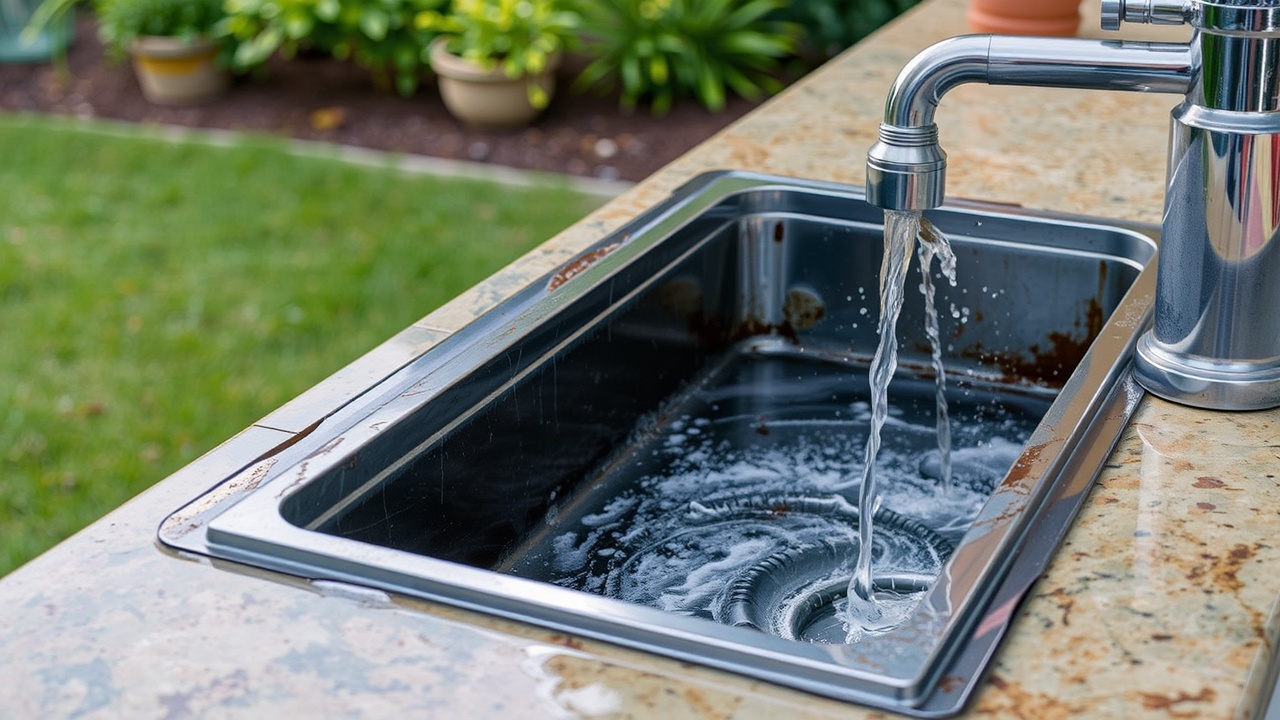Using a Grease Trap to Discharge Outdoor Bar Sink

Outdoor bar sinks are a fantastic addition to any backyard or patio setup, especially for those who love entertaining guests. However, when water and food particles flow through the sink, problems can arise if grease and oils are not properly managed. Using a grease trap to discharge outdoor bar sink waste is one of the most effective ways to keep your plumbing system running smoothly. This article will walk you through everything you need to know about grease traps, how they work, and why they are essential for your outdoor bar sink.
What Is a Grease Trap?
A grease trap is a plumbing device designed to capture fats, oils, and grease (often abbreviated as FOG) before they enter the drainage system. FOG can harden as it cools, causing blockages in pipes, septic tanks, or municipal sewer systems. Grease traps are commonly used in commercial kitchens, but they are equally beneficial for outdoor bar sinks in residential settings.
This device works by separating water from FOG. The heavier wastewater sinks to the bottom, while grease and oil float to the top. A grease trap holds the grease in a separate compartment, allowing only clean water to flow out into the main drainage system.
Why Is a Grease Trap Necessary for an Outdoor Bar Sink?
Outdoor bar sinks often handle more than just water. They deal with food scraps, oils from washing dishes, and even cocktail mixers. Without a grease trap, grease and debris can build up over time, causing serious problems such as:
- Clogged Drains: Grease solidifies in pipes, leading to restricted water flow.
- Unpleasant Odors: Accumulated grease can produce foul smells.
- Environmental Hazards: Improper disposal of grease contributes to water pollution.
- Costly Repairs: Fixing clogged or damaged plumbing can be expensive and time-consuming.
Using a grease trap to discharge outdoor bar sink waste prevents these issues, ensuring a cleaner, more efficient drainage system.
How Does a Grease Trap Work?
Grease traps use a simple yet effective process to separate fats, oils, and grease from wastewater. Here’s a step-by-step explanation:
- Wastewater Enters the Grease Trap: When water flows from the sink, it carries FOG and solid particles into the grease trap.
- Separation Occurs: Inside the trap, the water slows down. This gives grease and oil time to float to the top while heavier particles sink to the bottom.
- Clean Water Exits: The remaining water, now free of grease, is discharged into the drainage system.
- Grease is Retained: The grease and solids stay in the trap until they are removed during routine maintenance.
This process ensures that your plumbing system remains free from clogs and blockages caused by grease.
Types of Grease Traps
There are two main types of grease traps to consider when installing one for an outdoor bar sink:
Passive Grease Traps
Passive grease traps are smaller units designed for residential use. They are installed under the sink or nearby and work without electricity. These traps are affordable, easy to maintain, and ideal for outdoor bar sinks with moderate grease production.
Automatic Grease Removal Units (AGRU)
AGRU systems are more advanced and often used in commercial settings. They feature mechanisms to automatically remove grease from the trap, reducing the need for frequent manual cleaning. Although more expensive, AGRUs are an excellent choice for larger outdoor setups or high-use sinks.
How to Choose the Right Grease Trap for Your Outdoor Bar Sink
When selecting a grease trap, it’s important to consider several factors to ensure you choose the right one for your needs:
- Size of the Sink: The grease trap must handle the volume of water your sink produces. Larger sinks may require bigger traps.
- Material: Grease traps are made from stainless steel, plastic, or other durable materials. Stainless steel models are long-lasting but more expensive.
- Capacity: The grease trap should have enough capacity to handle FOG buildup between cleanings.
- Location: Consider where the trap will be installed. It should be easy to access for maintenance but discreet enough to blend with your outdoor space.
- Budget: Grease traps range in price, so choose one that fits your budget without compromising on quality.
Installation of a Grease Trap for an Outdoor Bar Sink
Installing a grease trap is a straightforward process, but it’s important to follow proper steps to ensure effectiveness:
- Assess the Plumbing System: Before installation, examine your plumbing setup to determine the best location for the grease trap. Ideally, it should be placed between the sink and the main drainage line.
- Choose the Right Size: Ensure the grease trap you select matches the flow rate of your sink. Most residential traps can handle standard outdoor bar sinks.
- Prepare the Area: Clear the installation site and ensure you have the necessary tools, such as wrenches and pipe cutters.
- Connect the Trap: Attach the grease trap to the sink’s drainpipe and the outgoing line leading to the main drainage system. Use fittings and clamps to secure the connections.
- Test the System: Run water through the sink to check for leaks and ensure the grease trap functions properly.
Although installing a grease trap is manageable for DIY enthusiasts, hiring a professional plumber is recommended to ensure everything is set up correctly.
Maintaining a Grease Trap
To keep your grease trap working efficiently, regular maintenance is essential. Here are some tips to maintain your grease trap:
- Schedule Cleanings: Grease traps should be emptied and cleaned regularly to prevent clogs. The frequency depends on usage but is typically every 1-3 months.
- Inspect for Damage: Check the trap for cracks, leaks, or other issues that could affect its performance.
- Avoid Overloading: Dispose of large food scraps in the trash instead of the sink to reduce strain on the trap.
- Use Enzyme Cleaners: Some enzyme-based cleaners are safe for grease traps and can help break down grease buildup.
Proper maintenance not only extends the life of your grease trap but also ensures your outdoor bar sink remains functional.
Benefits of Using a Grease Trap
The benefits of using a grease trap to discharge outdoor bar sink waste are numerous and far-reaching. Some key advantages include:
- Preventing Plumbing Problems: By capturing grease before it enters the pipes, grease traps reduce the risk of clogs and backups.
- Protecting the Environment: Grease traps prevent harmful fats and oils from polluting water sources.
- Saving Money: Avoiding plumbing repairs and fines for improper grease disposal saves homeowners money in the long term.
- Maintaining Hygiene: With proper waste management, unpleasant odors and unsanitary conditions are minimized.
These benefits make grease traps an invaluable addition to any outdoor kitchen or bar sink setup.
Common Issues with Grease Traps and How to Fix Them
Despite their effectiveness, grease traps can encounter problems if not properly maintained. Here are some common issues and their solutions:
- Clogged Trap: A grease trap can become clogged if it isn’t cleaned regularly. To fix this, empty the trap and remove any debris.
- Foul Odors: If grease is left in the trap for too long, it can produce unpleasant smells. Regular cleaning and enzyme treatments can resolve this issue.
- Slow Drainage: When water drains slowly, it may indicate a blockage in the trap or connecting pipes. Inspect the system and remove any obstructions.
By addressing these problems promptly, you can ensure your grease trap continues to function effectively.
Environmental Benefits of Grease Traps
Grease traps play a vital role in protecting the environment. When FOG enters natural waterways, it can harm aquatic life and disrupt ecosystems. Grease traps prevent this by capturing fats and oils before they reach the sewer system. Additionally, the waste collected in grease traps can often be recycled or repurposed, reducing landfill waste.
By using a grease trap, homeowners contribute to a more sustainable and eco-friendly approach to waste management.
Alternatives to Grease Traps
While grease traps are the most effective solution for managing FOG, some alternatives can be considered:
- Sink Strainers: Strainers catch solid food particles but do not separate grease from water.
- Dry Cleanup Methods: Wiping dishes with paper towels before washing can reduce grease entering the sink.
- Septic Additives: Certain additives help break down grease in septic systems, though they are not as reliable as grease traps.
These alternatives may work in low-grease situations but are not as comprehensive as a grease trap.
The Future of Grease Trap Technology
Grease trap technology is constantly evolving to meet the needs of modern kitchens and outdoor setups. Innovations include:
- Smart Grease Traps: These devices monitor grease levels and send alerts when cleaning is needed.
- Eco-Friendly Designs: New models focus on reducing energy use and utilizing recycled materials.
- Improved Filtration Systems: Advanced filters ensure even finer separation of grease and water.
As technology advances, grease traps will become even more efficient, making them an indispensable tool for waste management.
Using a Grease Trap to Discharge Outdoor Bar Sink Waste
Using a grease trap to discharge outdoor bar sink waste is not just about convenience—it’s about protecting your plumbing, the environment, and your investment in an outdoor kitchen. With the right grease trap, you can enjoy a hassle-free experience, whether you’re hosting a barbecue or simply rinsing glassware.
By understanding how grease traps work and maintaining them properly, you ensure that your outdoor bar sink operates efficiently for years to come. With so many benefits, installing a grease trap is one of the best decisions you can make for your outdoor space.
FAQs
What is a grease trap?
A grease trap is a device that separates fats, oils, and grease from wastewater to prevent clogs in plumbing systems.
Why is a grease trap necessary for outdoor bar sinks?
Grease traps prevent plumbing issues, unpleasant odors, and environmental harm by capturing grease before it enters the drainage system.
How do grease traps work?
Grease traps separate grease from water by slowing the flow of wastewater, allowing grease to float to the top and clean water to discharge.
What are the types of grease traps?
The two main types are passive grease traps, which are manual, and automatic grease removal units (AGRU), which remove grease automatically.
How often should a grease trap be cleaned?
Grease traps should be cleaned every 1-3 months, depending on usage, to maintain efficiency and prevent clogs.






